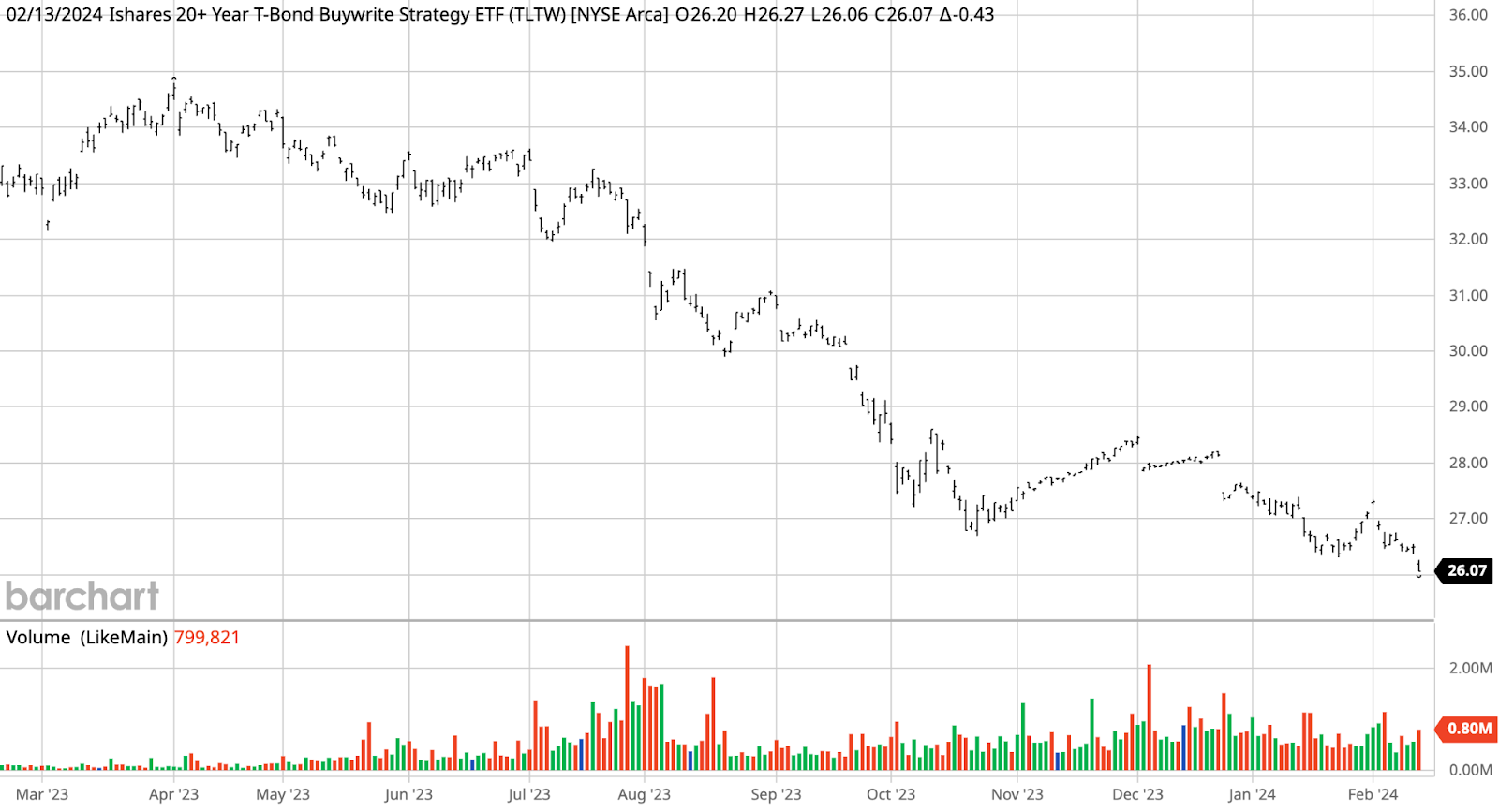If you’re an income investor, you may have noticed buy-write exchange traded funds (ETFs) pop up on your watchlists over the past year. Some of these funds have yields in excess of 10%, placing them well ahead of many dividend stocks and even fixed-income products. But, of course, everyone knows that higher yields often translate to higher risk.
In this article, we’ll look at how buy-write funds work and why they might not be quite as attractive as they seem on the surface, at least not to everyone.
What Are Buy-Write ETFs?
Buy-write ETFs, also known as covered call ETFs, own an underlying index or security that they write call options against (a position holistically known as a covered call). The option buyer pays a premium to secure the right to buy the security at a predetermined strike price over a predetermined length of time. And in exchange, the option seller (you) receives an immediate income.
Buy-Write Bond ETFs
These ETFs are sorted by their one-year total return, which ranges from -7.7% to 5.3%. They have AUM between $44M and $654M and expenses between 0.34% and 0.69%. They are currently yielding between 9.6% and 16.8%.
| Name | Ticker | Type | Actively Managed? | AUM | 1-year Total Ret (%) | Expense | Yield |
|---|---|---|---|---|---|---|---|
| iShares High Yield Corporate Bond BuyWrite Strategy ETF | HYGW | ETF | No | $44M | 5.3% | 0.69% | 14.2% |
| iShares Investment Grade Corporate Bond BuyWrite Strategy ETF | LQDW | ETF | No | $165M | 1% | 0.34% | 16.8% |
| iShares 20+ Year Treasury Bond BuyWrite Strategy ETF | TLTW | ETF | No | $654M | -7.7% | 0.35% | 9.6% |
The biggest risk of a conventional buy-write strategy on equities is missing out on potential upside beyond the strike price since stocks trend higher over time. But, in the case of buy-write bond ETFs, there’s an equal risk of losses from a drop in bond prices exceeding the income from options. And that’s especially true as the Federal Reserve has increased interest rates to combat inflation.

TLTW has seen a 23% drop in price over the past 52 weeks, which offset its gains from a nearly 20% yield over that timeframe. Source: Barchart.com.
That said, buy-write strategies may be better than simply holding the securities, right? The iShares 20+ Year Treasury Bond BuyWrite Strategy ETF (TLTW)—the most popular option of the bunch—holds recession-proof Treasury bonds. With the risk of a recession on the horizon, the fund could offer more income than the vanilla iShares 20+ Year Treasury Bond ETF (TLT).
What’s the Catch?
We already discussed the biggest catch with investing in buy-write funds: the fact you’re sacrificing potential upside and are still exposed to most of the downside (minus a buffer). But most investors purchase buy-write funds for monthly income distributions. So, they may feel comfortable sacrificing some upside potential. But it’s still important to quantify that trade-off, and that can be challenging.
For instance, you might be tempted to look at total return when comparing different fund options. However, the total return assumes that you reinvest monthly distributions. And that potential over-estimation of total returns rises as the yield increases. So, it’s critical to look at price returns instead of total returns.
Historical yields and returns can also be misleading. That’s because buy-write strategies work better in relatively sideways markets and worse in extreme up and down markets. While volatility might increase monthly income distributions, buy-write strategies don’t protect you from large moves downward and you risk missing out on more upside. As a result, there’s a higher loss or opportunity cost.
Asking the Right Question
We have seen that buy-write ETFs involve a series of trade-offs. If you want high yields, you must sacrifice upside potential while still accepting any downside beyond the buffer. Moreover, the amount of income depends on the volatility of the underlying asset. So, riskier investments tend to offer the highest yields. In other words, there’s no free lunch when it comes to buy-write strategies either.
A better question is: What are your goals?
If you want to maximize monthly income, buy-write ETFs offer income above and beyond what’s possible with dividend stocks and even many fixed-income securities. And if you’re using that income to fund retirement, you likely care far less about long-term capital gains. So, in that case, they might make a lot of sense for your portfolio if you’re replacing the same asset you’d otherwise hold.
But, if you want to maximize total returns, you should be sure to compare apples to apples. Buy-write ETF yields may look attractive on the surface, but the trade-offs could very well translate to a worse total return, as we’ve seen above with TLTW. Or they could offer a better total return but only in certain market conditions that may not last forever.
The Bottom Line
Buy-write ETFs offer excellent yields, but they come at a cost. Generally, the cost is worth bearing for income investors prioritizing monthly distributions. But for those looking for the best total returns, it’s worth looking beyond yields to determine the best option. And keep in mind that the best option may change depending on the economic cycle.





